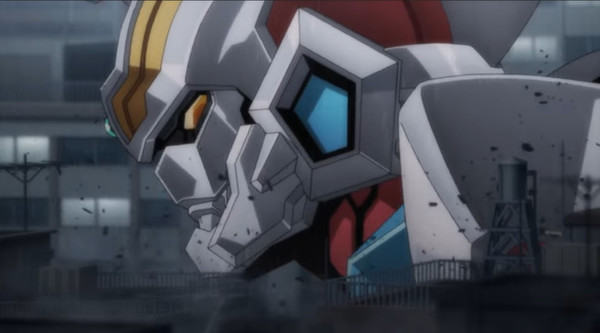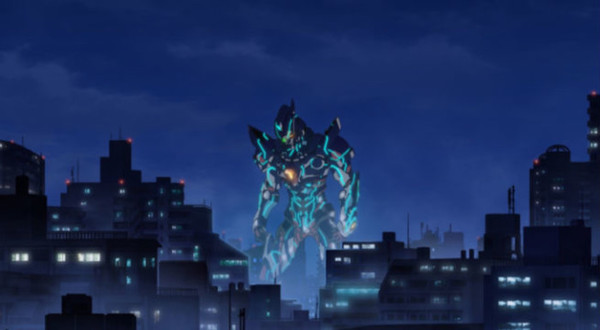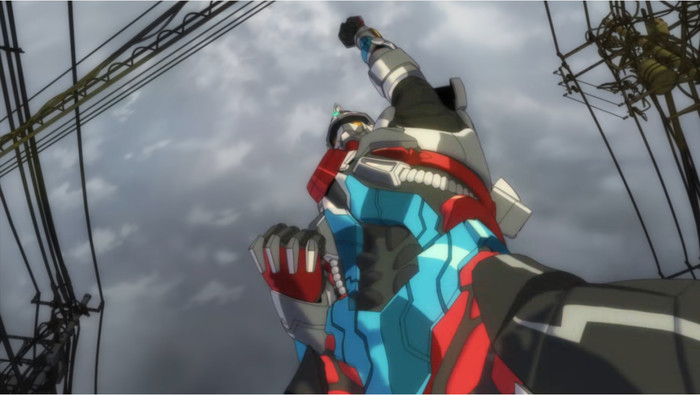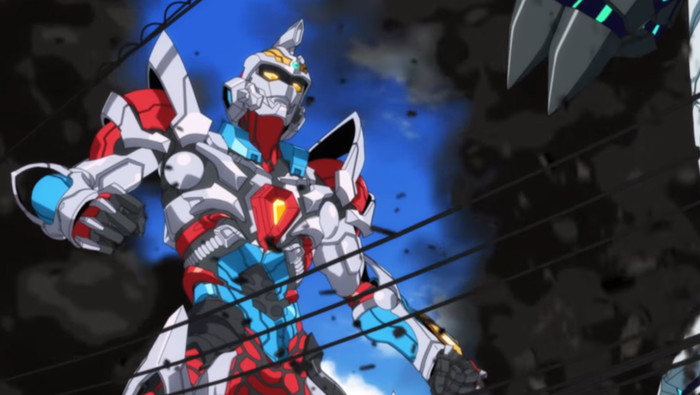Interview: SSSS.GRIDMAN with TRIGGER's Masaru Sakamoto and Masato Takeuchi
by Gabriella Ekens,It's a big year for Studio Trigger director Akira Amemiya. After helming two well-received short series (the adorable Space Patrol Luluco and the cult smash Inferno Cop), Amemiya has finally been handed his first full-length anime series to direct: SSSS.GRIDMAN, a TRIGGER-flavored reboot of the classic tokusatsu series (known to Americans as Superhuman Samurai Syber-Squad!). Though the show doesn't premiere until October, this year's Anime Expo in Los Angeles hosted both the premiere of the first episode of the series AND a couple of special guests: TRIGGER's Masaru Sakamoto, animator and character designer for the new series, and Masato Takeuchi, animation producer. Both of these talented artists sat down with us for a few moments during the show to talk about the big premiere, what their expectations are for this reboot, and a whole lot more.
ANN: In America, Gridman was released as Superhuman Samurai Syber-Squad (SSSS), which of course this new Gridman has in its title. Is there a connection with the American version of Gridman as well as the original?
Takeuchi: There's really no specific relation between the two shows, we just wanted the name to be something that fans overseas could recognize, to add a little more familiarity to the title. You can, however, expect for there to be some SSSS Easter Eggs in this new series, some references to peak interest overseas.
So, you're making the show with both a Japanese and international audience in mind?
Takeuchi: Yes, it's for both Japanese and overseas fans.
Can you tell us a little bit about how - and why - you're modernizing a tokusatsu series like Gridman?
Takeuchi: First of all, we've upgraded the designs into a more modern style. We actually asked Masayuki Gotou at Tsuburaya Productions, who designed the new Ultraman, to match the new, modernized version of that character.

To elaborate on that, what would you say are the main differences between this new design and the old one?
Takeuchi: It's more stylized because it's anime [in contrast to live-action tokusatsu]. Because of this, the body specs can be larger – our Gridman is taller, the arms and legs are longer, and the head smaller compared to tokusatsu. After all, in tokusatsu, an actual human has to be wearing the suit, so the body specs had to be more true-to-human. Anime gives you more freedom in this regard.
NOTE: during this interview, Takeuchi had an enormous Gridman figure on the table. As an aside, can I ask about the figure? How old is it?
Takeuchi: It's like over 20 years old. That's the type of toy that they used to make back then. It's my personal possession.
It's cool! I know some people who collect stuff like that myself.
Takeuchi: Yeah, I'm a collector. I was a big fan of the old tokusatsu series.
Takeuchi: If you'd like to hear a little more about modernizing Gridman, in terms of animation we're using a lot of 3D CG to add depth to the characters and animation. In 2D, it's hard to give the characters depth and weight, so we're trying to do with 3D.

I've seen that approach develop a lot over the past few years, especially with animated versions of tokusatsu properties. For example, in the recent Garo anime, you can see a big improvement from the suit CG in the first one, Garo: The Animation to the most recent, Garo: Vanishing Line.
Takeuchi: Yeah, I've seen that too. In general, we're seeing a lot more titles that incorporate both 2D and 3D, and I think that there's going to be more and more of that. This expands anime's expressive capabilities.
Sakamoto: Of course, 2D still plays a big role in creating an anime. We use 2D writers' and animators' work to create major aspects of the story, like special movements and things like that, but 3D is used to in addition to these scenes.
I remember these techniques being used throughout another TRIGGER show, Kill la Kill, so it seems like the studio is very used to integrating 2D and 3D animation.
Takeuchi: So if the fans like Kill la Kill, or Little Witch Academia, then they'd most likely enjoy SSSS.GRIDMAN.
Another question on the modernization – the story involves computers, but what is defined as a computer has changed a lot since the original Gridman was made. How will SSSS address current technologies?
Takeuchi: The big difference is that in the old series, the show's technology seemed very advance. Now, however, it's all very “present time.” It's every day life, but you include Gridman into it.

Ah, Gridman in a world with smartphone and Twitter.
Takeuchi: Yes, exactly that.
Do you think that this changes Gridman a lot?
Takeuchi: Probably not that much.
You emphasized last year that this would be an original story not tied to the original Gridman? Can you talk a little more about why that is or if those plans have changed?
Takeuchi: It is still going to be original.
Sakamoto: We still want it to appeal to older fans, but we did modernize the characters to appeal to young people. For example, we set the story in high school, so that other fans – just regular anime fans – will be able to watch and enjoy as well.
Takeuchi: That's actually a big point that we discussed with the director, Amemiya-san, since he wanted to include a lot of old references and characteristics of the original series. We had a lot of back-and-forth discussion over how much to include, and whether certain things should be included at all. After all, if in too much it might alienate the new fans, and we didn't want to do that. At the same time, however, we still wanted to make our show feel true to the original.

On the subject of Director Amemiya, this is his first time directing a TV series, yes? How do you think he's handling the task?
Takeuchi: He's actually great as a director. He should have been a director for a long time, I feel like. Due to his personality, his staff are very loyal to him, and his ideas are very keen. He's a great, great director.
Sakomoto: He listens to everybody. He hears ideas and takes everybody's ideas into account. Of course, if that doesn't work out, then he'll change it, but he does actually listen to people and have discussions with them.
Can you tell me a little more about the show's timeline? Basically, who came together to decide to make SSSS.GRIDMAN?
Takeuchi: There's an event put on by Studio Khara called Animator Nippon Ichi, which is next to a trailer festival. There, Studio Khara approached TRIGGER and said, “hey, would you like to make a few PVs?” So we discussed what we might like to do and asked Tsuburaya Productions if we could borrow any of their IPs. We got offers for Gridman. Amemiya-san liked Gridman, so that's what we did. Afterwards, Tsuburaya's subsidiary Field's Production liked the PV that we created for Gridman, and asked if we could make something longer.
Sakamoto: This was probably around 2 or 3 years ago?
Can you tell me more about your personal histories with Gridman, as well as tokusatsu in general?
Takeuchi: Both the director and I did rewatch the old series just to recap the good points that we want to bring into this new one.
How long is the original Gridman?
Takeuchi: 39 episodes. It was 25 years ago.
Ah, that's not too long for those things. So did you watch Gridman as a kid?
Takeuchi: Of course, I used to roleplay as Gridman when I was a kid with my dad and brother. They were my monsters, and I was Gridman. My brother was a fan too, so we would both rent VHS tapes and watch the show. Sunday was Gridman day.

Is tokusatsu popular at TRIGGER? Do a lot of people at the studio share this background with you?
Takeuchi: Actually, not really. There aren't a lot of fans of tokusatsu at TRIGGER.
Sakamoto: Actually, it kind of worked in out favor that there aren't many tokusatsu fans at TRIGGER. This is because, as we said earlier, we want to modernize Gridman with this anime. We didn't force people working on our show to watch the original, or anything like that. As for those who had watched it, of course we involved their ideas. But at the same time, we feared that if too many people involved were fans of the original, then the show would be too niche, too much for the core fans only. And we didn't want that. So we purposely avoided including too many people who were familiar with the original Gridman.
It sounds like you've put a lot of thought into the balance of appealing to both newer and older audiences.
Takeuchi: Right now TRIGGER works with a lot of younger creators, so production environment we have right now is very open. Everyone is free to speak and exchange their ideas. This helps us have a lot of fresh ideas even though we're working on an old IP. Actually, in a production meeting, some of the younger people actually remembered Gridman's pose and catchphrase. Amemiya-san and I were amazed, since we didn't expect them to be able to reference something so old.
I'm seeing something similar happen here in the United States. Due to DEVILMAN crybaby on Netflix, everyone just has discovered Devilman, and now they're all talking about it or cosplaying it. It'd be fun if something similar happened with Gridman.
Takeuchi: Yes, that's what I hope for. I said the same thing at my panel – that next year, I want to see all of you doing Gridman's salute!
To end our interview, can you see TRIGGER doing more collaborations with other studios?
Takeuchi: Nothing that we can speak of, but yes, when the opportunity arises we are very open to collaboration.
Our thanks to Masaru Sakamoto, Masato Takeuchi, Anime Expo and Funimation for this opportunity.
discuss this in the forum (18 posts) |